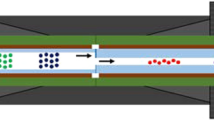Summary
Electrochromatography (that is HPLC where the eluent is driven along the column by electro-osmosis using fields of up to 100 kV m−1) promises plate efficiencies for HPLC which are comparable to those attained in capillary gas chromatography, but this requires that narrow-bore columns can be successfully packed with submicron particles. This paper demonstrates that we have now moved a considerable distance towards this goal. We show (1) that, following theory, there is no evidence of any reduction in electroosmotic velocity in columns packed with particles down to 1.5 μm diameter, (2) that reduced plate heights as low as unity are attainable for unretained solutes using both slurrypacked and drawn-packed columns 30 to 200 μm bore and up to 1 m long when packed with conventional 3 and 5 μm silica gels or with 1.5 μm impermeable silica spheres, (3) that columns driven electrically show higher plate efficiencies than identical columns driven by pressure, and (4) that 100,000 plate HPLC separations can be achieved in relatively short times of 30 minutes using in situ derivatised drawn packed capillaries containing 3 and 5 μm ODS-silica gels.
Similar content being viewed by others
Abbreviations
- c:
-
Concentration of electrolyte mol m−3
- Dm :
-
Diffusion coefficient of analyte in the mobile zone m2s−1
- dp :
-
Particle diameter m (or μm)
- d:
-
Capillary internal diameter m (or μm)
- d0 :
-
Capillary outer diameter m (or μm)
- E:
-
Electric Field V m−1
- F:
-
Faraday constant 96500 C mol−1
- H:
-
Plate height H.E.T.P. m (or μm)
- I:
-
Electrical current A
- K:
-
Thermal conductivity of electrolyte W m−1 K−1
- L:
-
Column length m (or mm)
- N:
-
Number of theoretical plates
- ΔP:
-
Pressure drop across column N m−2 (or bar)
- Q:
-
Heat generated per unit time per unit volume of electrolyte W m−3 s−1
- R:
-
Universal gas constant 8.314 J mol−1 K−1
- T:
-
Absolute temperature K
- tb :
-
Effective peak or front start time see text
- te :
-
Effective peak or front end time see text
- t1 :
-
Elution time minus peak or front standard deviation see text
- tm :
-
Elution time of an unretained species s
- tr :
-
Elution time plus peak or front standard deviation see text
- u:
-
Linear velocity m s−1 (or mm s−1)
- V:
-
Voltage across full length of capillary V (or kV)
- ΔTair :
-
Temperature excess in air surrounding column K
- ΔTcore :
-
Temperature excess in column core K
- δ:
-
Electrical double layer thickness m (or nm)
- ɛr :
-
Relative permittivity dimensionless
- ɛ0 :
-
Permittivity of a vacuum 8.85×10−12C2N−1m−2
- ϕ:
-
Dimensionless flow resistance parameter dimensionless
- λ:
-
Tortuosity Factor dimensionless
- θ:
-
Angle between a given interparticle channel and the capillary axis
- η:
-
Eluent viscosity N s m−2
- σ:
-
Surface excess charge density C m−2
- ζ:
-
Zeta potential V (or mV)
References
J. H. Knox, Chromatographia26, 329 (1988).
J. W. Jorgenson, K. D. Lukacs, J. Chromatogr.218, 209 (1981).
S. Terabe, K. Otsuka, T. Ando, Anal. Chem.57, 834 (1985).
A. Guttman, A. Paulus, A. S. Cohen, N. Grinberg, B. L. Karger, J. Chromatogr.448, 41 (1988).
J. H. Knox, I. H. Grant, Chromatographia24, 135 (1987).
S. Wu, N. J. Dovichi, J. Chromatogr.480, 37 (1989).
R. A. Wallingford, A. G. Ewing, Anal. Chem.60, 1975 (1988).
V. Pretorius, B. J. Hopkins, J. D. Schieke, J. Chromatogr.99, 23 (1974).
D. J. Shaw “Introduction to Colloid and Surface Chemistry”, Butterworths, London, 1980.
C. L. Rice, R. Whitehead, J. of Phys. Chem.,69, 4017 (1965).
J. J. Van Deemter, F. J. Zuiderweg, A. Klinkenberg, Chem. Eng. Sci.,5, 271 (1956).
J. H. Knox, in “Techniques in Liquid Chromatography”, Ed. Simpson, Wiley Heyden, UK, 1982, p. 1–56.
J. H. Knox, L. McLaren, Anal. Chem.36, 1477 (1964).
J. K. Roberts, “Heat and Thermodynamics” 3rd. Edn., Blackie, London, 1947, p. 245–251.
J. H. Knox, K. A. McCormack, 18th Int. Symp. on Chromatogr. 23–28 Sept. 1990, Amsterdam, Abst. No. Fr-L-08.
T. S. Stevens, H. J. Cortes, Anal. Chem.55, 1365 (1983).
N. Tanaka, H. Kinoshita, M. Araki, T. Tsuda, Int. Symp. on HPLC, Kyoto, Japan, Jan. 28th–30th, 1985. Abs. No. 50128.
F. G. Yang, J. Chromatogr.236, 265 (1982).
D. Ishii, T. Takeuchi, J. Chromatogr.255, 349 (1983).
H. Alborn, G. Stenhagen, J. Chromatogr.323, 47 (1985).
T. Tsuda, I. Tanaka, G. Nakagawa, Anal. Chem.56, 1249 (1984).
A. G. Rowley “Unpublished”, University of Edinburgh, UK.
W. Stober, A. Fink, E. Bohn, J. Colloid and Interface Sci.,26, 62 (1968).
Author information
Authors and Affiliations
Rights and permissions
About this article
Cite this article
Knox, J.H., Grant, I.H. Electrochromatography in packed tubes using 1.5 to 50 μm silica gels and ODS bonded silica gels. Chromatographia 32, 317–328 (1991). https://doi.org/10.1007/BF02321428
Received:
Revised:
Accepted:
Issue Date:
DOI: https://doi.org/10.1007/BF02321428




